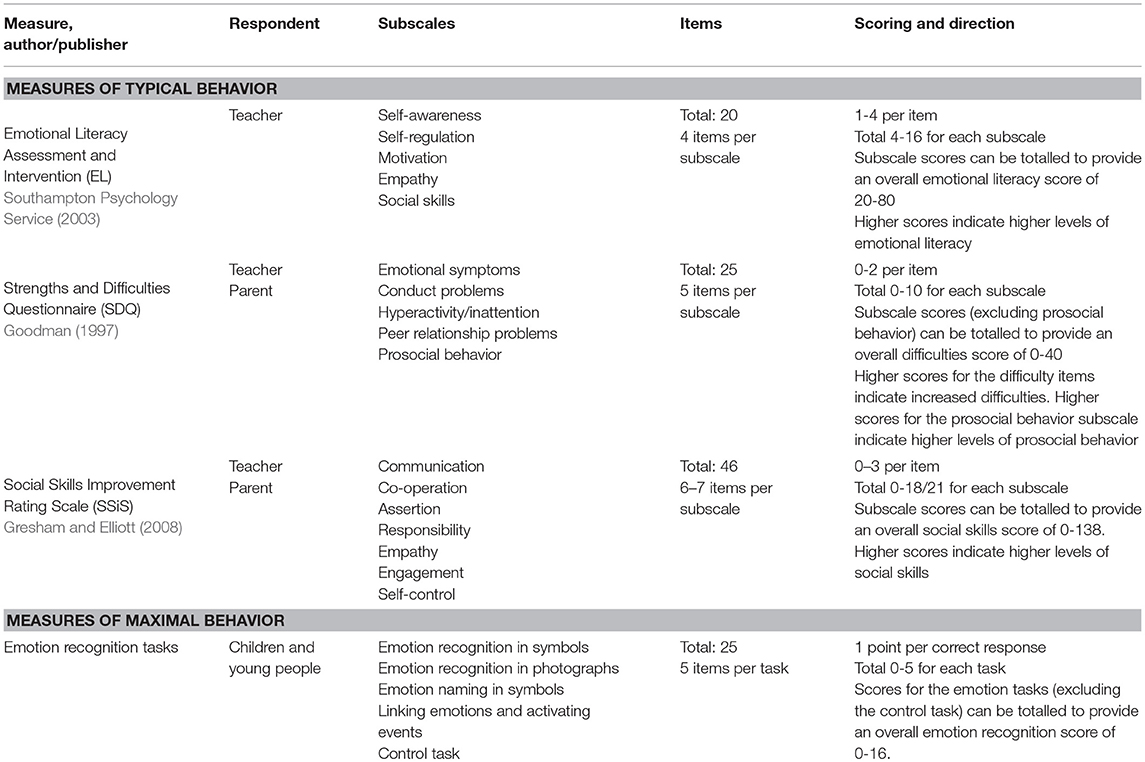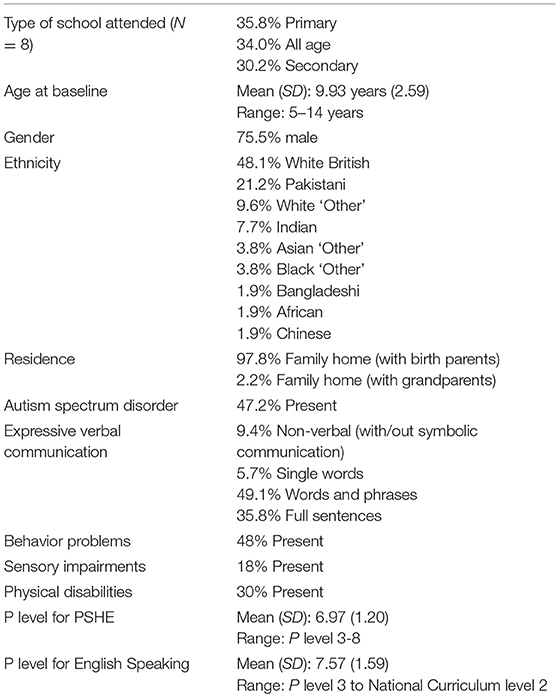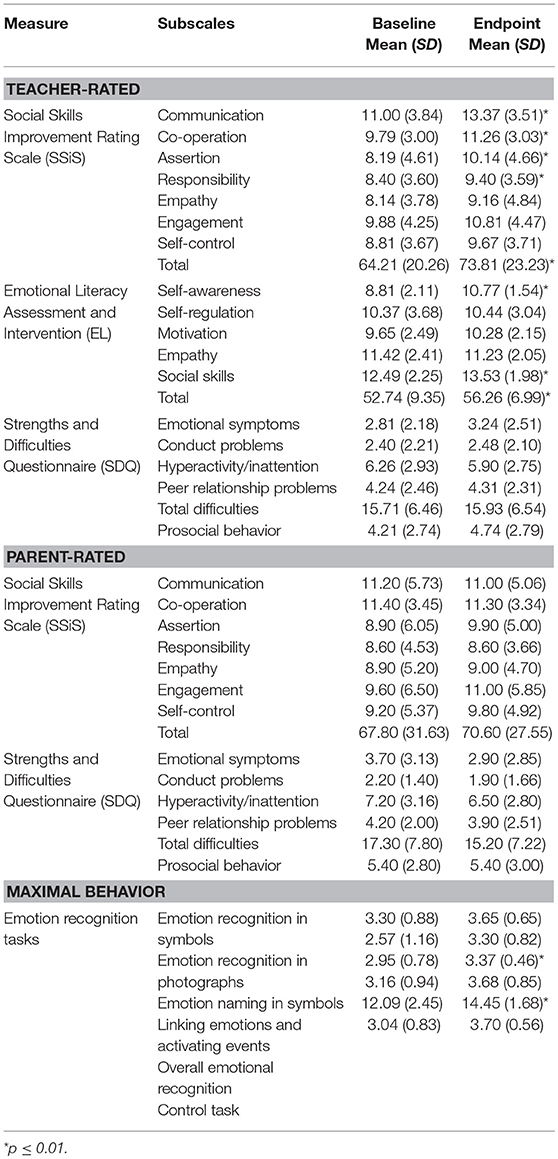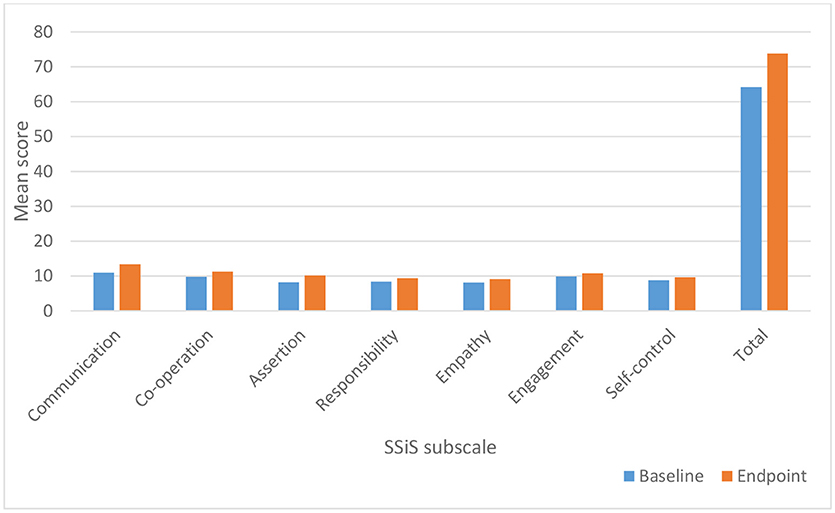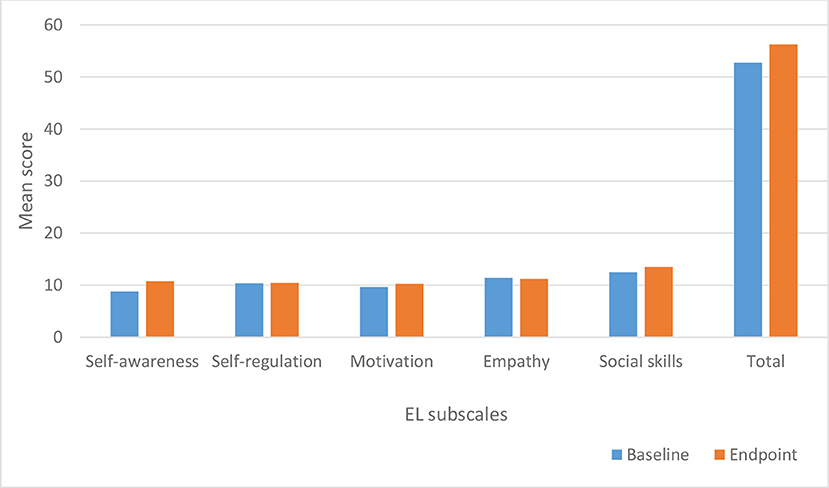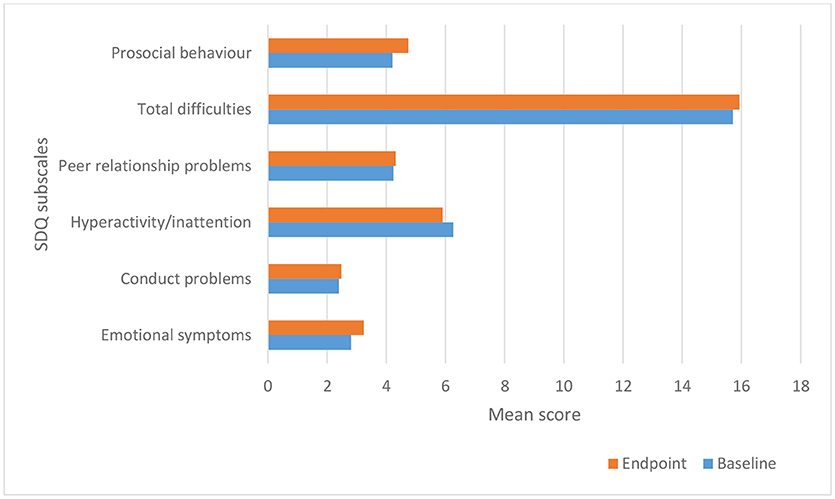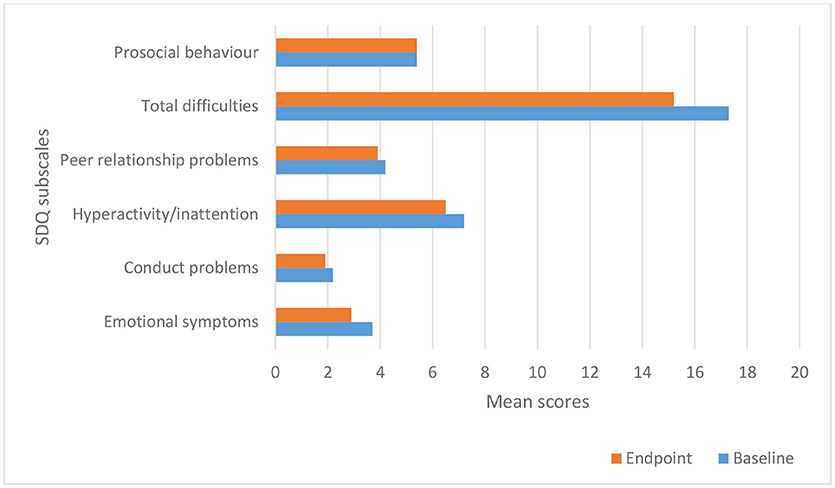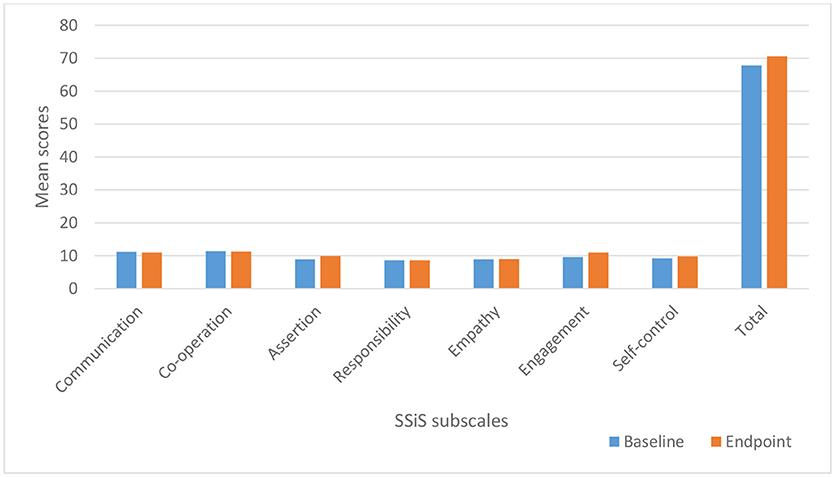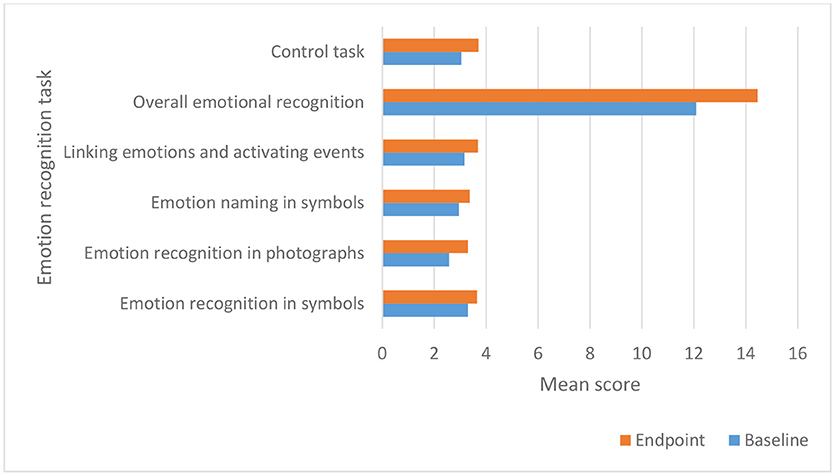- School of Psychology, University of Birmingham, Birmingham, United Kingdom
Background: Research evidence suggests that a child's emotional, social and psychological well-being influences their future health, education and social prospects, and that positive, well-developed coping skills and high emotional literacy lead to improved self-esteem, reduced stress, and reduced incidence of serious emotional problems in later life. Children with special educational needs and disabilities (SEND) are at a disadvantage as they tend to have lower levels of emotional literacy and may have limited opportunities or capacity to develop coping skills. Few targeted, evidence-based programmes aimed at improving emotional literacy and coping skills are currently available for use in SEND schools.
Aims: To evaluate the effectiveness, acceptability and feasibility of the school-based mental health promotion programme Zippy's Friends in SEND schools. The study concentrated on the first three modules of the programme, implemented over the course of an academic year in a cohort of children and young people with SEND.
Methods: Fifty-three children and young people attending eight SEND schools participated in the educational programme and study. Quantitative and qualitative data were collected using standardized assessment scales, purposed-designed questionnaires, emotion recognition tasks and interviews to assess typical and maximal behavior of the children as well feedback on the programme. Data were collected from children, parents/guardians/care givers, and teachers before and after the intervention. The results of the qualitative data will be presented elsewhere.
Results: Teachers' ratings indicated that the children's and young people's social skills, emotional literacy, and emotional recognition improved over the course of the study. Significant improvements were observed in teachers' ratings of communication, cooperation, assertion, responsibility, and self-awareness. Parental ratings did not change over time.
Conclusions: This small-scale study indicates that the Zippy's Friends programme is feasible and may lead to improved emotional literacy. However, further research is needed that uses a comparison group to isolate the effects of the programme from factors such as age-related maturation, development, and usual school-based learning.
Introduction
Research evidence suggests that a child's emotional, social and psychological well-being influences their future health, education, and social prospects. Children who experience emotional and social problems are more likely in later life to misuse drugs and alcohol, have teenage pregnancies, lower educational attainment, be untrained, unemployed, and involved in crime or violence (Adi et al., 2007a,b). Children with mental health and behavioral problems are also more likely to have mental health problems as adults (Price and Robins, 1991; Caspi et al., 1996). Furthermore, adults who exhibited “troubled behavior” in childhood account for 10 times the cost to public services as adults compared with those with no such problems in childhood (Donovan and Spence, 2000).
The World Health Organization recognizes the importance of coping skills for mental well-being (World Health Organization, 2001). Ineffective coping skills can lead to problems in psychological development, including depressive symptoms (Herman-Stabl et al., 1995; Kraag et al., 2006). Conversely, developing adaptive coping skills can improve self-esteem, prevent dysfunctional stress reactions, and reduce incidence of serious emotional problems (Mantzicopoulos, 1997; Sandler et al., 2000; Spence et al., 2003). Coping with stress “refers to changing cognitive and behavioral efforts to manage specific demands that are appraised as taxing or exceeding the resources of the person” (Lazarus and Folkman, 1984). There is evidence that children and adults with a wider repertoire of coping strategies experience fewer negative consequences from stressful situations, both in the short and long term (Mishara, 2007).
Clinically diagnosed mental disorders may affect 10% of children and young people (Green et al., 2004; Emerson and Hatton, 2007) with the incidence of mental health problems among children and adolescents with intellectual disabilities (ID) increasing to 36%. Epidemiological research has also found evidence that children and young people with ID have higher levels of social and emotional problems than typically developing children and as many as 50% of those with ID have clinically significant problems (Dekker et al., 2002). The high prevalence of mental health and behavioral problems in children as well as adults with ID (e.g., Deb et al., 2001; Cooper et al., 2007; Lundqvist, 2013) indicates that teaching emotional management and coping skills are components of the SEND syllabus that are as yet under-emphasized.
The National Institute for Health and Care Excellence in the UK (National Institute for Health Care Excellence, 2008) published guidelines to promote social and emotional well-being in primary school education. NICE recommends that help should be provided for those most at risk, or already showing signs, of social, emotional and behavioral problems, and that schools should be equipped to deliver programmes to develop children's social and emotional skills. Such skills include problem solving, coping with stress, conflict management/resolution, and understanding and managing feelings. The UK Government also recognizes the importance of promoting social and emotional well-being in their National Initiative, Social and Emotional Aspects of Learning (SEAL; Department for Children Schools and Families, 2007) but, as yet, there are no adaptations for children with SEND. More recently, the UK Department of Health (2015) published a report which promotes building resilience, preventative methods, and early intervention for mental health and well-being of children and young people. The report implicates universal services, such as schools, in supporting children and young people's well-being through delivering mental health promotion and prevention activities which are best provided on a whole-system basis. The school environment may be especially suited to mental health promotion activities as it is a place of learning and the acquisition of new skills (Ladd et al., 2002) and it can overcome barriers associated with clinic-based treatment such as transportation, cost, timing, location and stigmatization (Masia-Warner et al., 2006). There are thousands of such school-based interventions across the world and different terminology has been used to describe their content such as mental health, social and emotional learning, emotional literacy, emotional intelligence, resilience, and life skills (Weare, 2010).
A number of systematic reviews have been conducted to evaluate the effectiveness of school-based mental health interventions and Weare and Nind (2011) undertook an extensive review of those reviews. They found that teaching social and emotional skills and developing competence were central parts to effective interventions and that these programmes resulted in a wide range of specific outcomes such positive youth development and reduced depression, anxiety, conduct disorders, bullying, conflict and anger. They also found that emotional literacy interventions were more effective when teachers reinforced programme content in all classroom interactions and an interactive, experiential format was used which included games, activities, and group work.
Zippy's Friends is a preventative educational programme for children aged 5-7 years. It has been used in mainstream schools since 2002 and is currently implemented in over 29 countries. The programme was developed by Mishara and colleagues as a universal, low-cost programme that is flexible and not resource intensive so it can be delivered in schools worldwide, regardless of culture or language (Mishara and Bale, 2004). The programme is currently co-ordinated by Partnership for Children, a charity based in the UK. Partnership for Children promotes mental well-being in children across the world and has more recently developed a SEND supplement with adapted resources for use with children with SEND of primary and secondary school age.
Zippy's Friends is focussed on improving emotional literacy to enable children to develop skills that can lead to improved adjustment to social stressors and to psychological well-being in later life. Emotional literacy is defined as the ability to recognize, understand, manage, and express emotions (Sharp, 2001). Salovey and Mayer (1990) identify five domains, namely, self-awareness, ability to manage emotions, self-motivation, empathy, and relationship skills. The aim of Zippy's Friends is to support children to develop skills relating to these five domains with a focus on problem solving and expanding their repertoire of coping skills (Mishara and Bale, 2004; Partnership for Children, 2007). Furthermore, improving adaptive skills to appraise situations and evaluate the relative utility of coping strategies is central to the programme (Mishara, 2007). The programme takes a positive, solution-focussed approach to emphasize positive emotions, strengths and sources of support.
A systematic review found support for the effectiveness of Zippy's Friends in relation to children's use of coping skills, increased emotional vocabulary and positive behaviors (Wills, 2010). The review identified four English-language controlled studies, conducted in England, Denmark and Lithuania between 2000 and 2010. Since Wills' review, Clarke and Barry's 2010 research on the effect of Zippy's Friends on the emotional well-being of 523 primary school children in ‘disadvantaged' schools in Ireland found a significant positive effect of Zippy's Friends on emotional literacy, with significant increases in self-awareness, self-regulation, motivation, empathy, and social skills. No programme effects were found, however, for behavioral problems as measured by the Strengths and Difficulties Questionnaire, which is made up of four subscales: emotional symptoms, conduct problems, hyperactivity/inattention, and peer relationship problems. In a follow-up, Clarke et al. (2014) reported that the significant increase in emotional literacy in the intervention group was maintained after 12-months. Holen et al. (2012) conducted a large randomized controlled trial with 1483 7-8 years old children in Norway. They found the Zippy programme to have a significant positive impact on coping and mental health outcomes. Coping improved more significantly in girls, whereas mental health improved more in boys. One limitation of these studies is that they rely on informant measures from teachers who are not blind to the status of the participants or the aims of the research, so there is a risk of response bias.
Zippy's Friends for pupils with SEND was developed by Partnership for Children as a supplement to the mainstream version to address the paucity of resources specifically designed for improving emotional literacy and coping skills amongst children with SEND. Owing to the increased vulnerability to psychological stress and mental health problems amongst children with SEND and later, adults with ID, investment in such programmes is warranted. Zippy's Friends for children with SEND has not yet been formally evaluated, so this study aimed to investigate the feasibility, acceptability, and effectiveness of the SEND programme.
Aims
1. To evaluate the effectiveness of Zippy's Friends (restricted to modules 1–3 to ensure the study could be completed within one academic year; see section on Zippy's Friends) as an intervention for improving social skills, coping skills, and emotional literacy in pupils with SEND.
2. To assess the feasibility of the research methods, including provision of the intervention, recruitment and assessment procedures.
3. To investigate process issues in the implementation of the intervention, including fidelity, mechanisms of impact and effect of context.
4. To explore the experience and acceptability of the intervention to children and young people, parents/guardians, and teachers (including assistants).
5. To ensure that issues of diversity (gender, ethnicity, age, and ability) are considered in data collection, analysis, and discussion.
In this paper, only the quantitative data will be reported and discussed. For this reason only Aims 1, 2, and 5 will be addressed here. The qualitative component of the study that was designed to address Aims 3 and 4 are reported elsewhere (Unwin and Stenfert Kroese, 2016).
Materials and Methods
A repeated measures study of children and young people with SEND who participated in the Zippy's Friends for SEND programme (modules 1-3). Participating schools started the programme between November 2014 and January 2015. Quantitative data collection included testing children and young people (to assess maximal behavior) and questionnaires completed by informants (teachers/teaching assistants and parents/guardians/caregivers to assess typical behavior) administered at baseline, prior to the intervention (October–December 2014) and at end-point (May–August 2015). Qualitative interviews with teachers at mid- (January–May 2015) and end-point (May–July 2015) were also conducted and a sub-sample of parents and children were interviewed after completion of the programme (August–September 2015). The methods for and results of these interviews are presented elsewhere (Unwin and Stenfert Kroese, 2016).
The Mental Health Promotion Intervention: Zippy's Friends for SEND
Zippy's Friends, coordinated by the charity Partnership for Children (www.partnershipforchildren.org.uk) is a manualised, educational, mental health-promotion package comprising six modules. It takes a socio-ecological approach, recognizing the child as part of a family, peer group and school system. It is based around a set of six illustrated stories about a stick insect called “Zippy” and his friends (a group of young children). Each story involves Zippy and his friends confronting issues that are familiar to young children including friendship, communication, feeling lonely, bullying, dealing with change and loss, and making a new start (module titles: Feelings, Communication, Making and Breaking Relationships, Conflict Resolution, Dealing with Change and Loss, and Coping).
The programme is delivered by teachers and teaching assistants during routine classroom time, typically over a 24-weeks period with one 45-min session per week (four sessions per module, 24 sessions in total). Each session begins with a review of what pupils learned the previous week. The teacher then reads part of the story followed by the pupils participating in two activities such as playing games, drawing or discussion. Repetition is a key feature of the programme to reinforce key messages and embed learning.
The SEND programme closely aligns with the mainstream programme but has additional resources and supplements to facilitate the implementation of the programme to children with a wide range of abilities. The SEND programme provides a selection of alternative activities (around five for each of the mainstream activities), and the stories have been adapted at four different ability levels using WIDGIT symbols (www.widgit.com; 2002). The activities include craft sessions, completion of worksheets, role-plays, discussion and use of metaphors.
Whilst the mainstream programme was developed for children aged 5-7 years, the SEND programme was designed to be appropriate for a wider age range to include those in primary and secondary education. Teachers are advised to take a flexible approach to make the programme suitable for their pupils. Owing to the increased complexity of running the programme with SEND pupils, completion may take longer to allow for shorter sessions, repetition of sessions, or completion of a range of activities attached to each session before moving onto the next. Therefore, this study evaluated the first three modules to ensure adequate time for completion within one academic year, and allowing time for end-point data collection. The first module aims to improve the ability to recognize difficult feelings and to use coping strategies to deal with those feelings. The second module aims to improve the ability to communicate feelings and more general communication with others. The third module aims to improve the ability to make friends and to cope with rejection and loneliness.
Prior to running the programme, teachers attended a 1-day training course. Teachers also received standard support and supervision through direct observation of one session and attendance at two support meetings. Additional telephone and email support was available upon the request of the teacher. All training and support was provided by Partnership for Children.
Participants and Recruitment
Schools were recruited from three locations in England, namely the West Midlands, Northamptonshire and the South-East. SEND schools were identified from those known to the research team, those known to Partnership for Children, internet searching, Local Authority lists of special schools and through networks of special schools. Websites of potentially eligible schools were screened for relevance: those specializing in education for pupils with profound and multiple intellectual disabilities, sensory needs, or ages below 6 or above 15 years were not contacted.
Forty-three schools representing a range of independent, local authority, primary, secondary, co-educational, urban, rural, faith and non-faith schools were contacted by email and phone. Interested schools were provided with information packs. Recruitment closed when the target number of schools had been reached and schools were closing for the 2014 summer break.
Ten community day (non-residential) SEND schools were recruited. Two schools subsequently withdrew due to a lack of capacity and changes in circumstances, leaving a sample of eight schools. Seven schools were local authority maintained and one was independent. All schools were mixed gender and provided education exclusively to pupils with SEND; one school was a specialist school for pupils with autism. Three were primary schools (pupils aged 3–11 years), two were secondary with colleges (pupils aged 11–19 years) and three were all-age for pupils aged up to 19 years.
A teacher in each school was selected to coordinate the programme. Teachers were selected through discussion with Head Teachers or other school representatives based on their motivation and openness to the approach. Schools were offered flexibility in how they implemented the programme: six schools chose to involve an existing class and two schools formed a class specifically for the programme, drawing pupils from multiple classes to ensure that at least five pupils met the eligibility criteria described below.
Eligibility Criteria for Individual Children and Young People:
• Aged 5 to 15 years
• Performance (P) level for Personal, Social and Health Education (PSHE) between 5 and 8, based on the most recent assessment
• Performance (P) level for English Speaking of at least 4 (to indicate presence of communication through at least single words, signing or symbolic communication)
• Absence of significant hearing or visual impairments that may limit the child's access to the programme (determined through discussion with the teacher, on a case-by-case basis).
The Performance (P) Scales (Qualifications and Curriculum Authority, 2009) are statutory assessment scales in the UK used when reporting attainment for pupils with SEND who are working below Level 1 of the National Curriculum. P level assessment is not compulsory for Personal, Social and Health Education (PSHE), but is commonly assessed in schools toward the end of each academic year. The assessment carried out at the end of the academic year 2013-2014 was used to screen potential child participants. A P level 4-5 for PSHE indicates that the child can maintain interactions in small groups with some support and can combine two elements of communication to express feelings, needs and choices. A P level of 8 indicates that the child demonstrates autonomy and awareness of others. P levels for PSHE were not available for one school so the teacher was asked to provide estimations.
Parental/guardian consent was sought using postal recruitment packs sent to the parents/guardians of each eligible child in the identified class. A letter of invitation, information sheet, reply slip, and pre-paid envelope were included in each pack. The packs were sent out by administrators on each school so that personal information was not transferred until after parents/guardians had been provided with sufficient time to opt out. An opt-out system for recruitment was selected to minimize any burden on parents/guardians and because the intervention closely aligned to usual teaching practice, all research activities were conducted within school premises and hours, and teachers are legally competent to give consent in loco parentis for children in their care for school-like activities. Parents/guardians were given over 2 weeks to respond and only one parent returned a reply slip to decline participation.
Assessments and Outcome Measures
A range of measures was used to assess typical and maximal behavior of the child participants (see Table 1). These measures were selected as they sought to measure constructs aligning with the aforementioned five domains of emotional literacy. Emotional Literacy Assessment and Intervention (EL; Southampton Psychology Service, 2003) has five domains directly relating to those proposed by Salovey and Mayer (1990). The Social Skills Improvement Rating Scale (SSiS; Gresham and Elliott, 2008) broadly covers these domains, but is organized into different subscales which have more of a focus on social skills. The Strengths and Difficulties Questionnaire (SDQ; Goodman, 1997) measures prosocial behavior as well emotional, interpersonal and behavioral difficulties. Informant-rated social, emotional and coping skills and problem behavior were assessed at baseline (defined as 1–12 weeks prior to the intervention and at least 8 weeks into the start of the academic year to allow children to settle) and end-point (3–8 weeks after completion of the third module). Self-complete, postal questionnaires were sent to parents/guardians and teachers who were asked to rate each child participant for the previous 6 months period at baseline (or the period they had known the child if less than 6 months) and the previous 1 month period at end-point. Parents/guardians were offered the option of completing the questionnaire as a telephone interview and reminder letters were sent to those not responding.
The measures of maximal behavior sought to assess emotional literacy directly through emotional recognition tasks with children. Emotion recognition tasks were conducted at baseline and end-point with a sub-sample (N = 25) of children (child participants in two West Midlands schools were invited to take part). The tasks were designed by the research team and are based on those used in previous research by Dagnan and Proudlove (1997) and Reed and Clements (1989). All assessments were conducted at school, by a member of the research team, in a quiet room or a quiet space within the classroom. The order of the tasks and items within each task were randomized across participants to control for order effects and participants were not given any feedback on the accuracy of their responses.
Demographic information relating to the child participants was collected from teachers at baseline using a self-complete questionnaire (date of birth; gender; ethnicity; cultural/religious affiliations; living arrangements; expressive verbal communication; comorbid diagnoses, including autism spectrum conditions, mental health conditions, genetic conditions, physical health conditions, physical disabilities, and sensory impairments; family structure; current interventions, including medication and psychological and medication).
Emotional Literacy: Assessment and Intervention (EL)
Emotional Literacy: Assessment and Intervention (EL; Southampton Psychology Service, 2003) measures strengths and weaknesses in emotional literacy and facilitates the identification of areas for intervention. It was designed to be used in school settings and there are two versions: a Primary version for children aged 7–11 years and a Secondary version for children aged 11–16 years. The measure was specifically designed to screen pupils with problems with emotional literacy and is therefore more sensitive to differences between low scorers than high scorers. Standardized pupil, teacher and parent questionnaires are provided to assess individual children and young people, which can be used for re-assessment to monitor progress. Only the teacher assessment questionnaires were used in the present study to minimize burden on parents. The pupil assessment was not used as it was felt that the child participants in this study would be unable to respond to the questions. The version corresponding with each child participant's age was used.
Strengths and Difficulties Questionnaire (SDQ)
The Strength and Difficulties Questionnaire (SDQ; Goodman, 1997) can be used with children aged 3–16 years and has different versions to be completed by teachers, parents/guardians/care givers or the young person themselves. Follow-up questionnaires are provided to rate the impact of interventions. The teacher-completed and parent-completed pre-intervention and follow-up questionnaires, were used in this study.
Social Skills Improvement Rating Scale (SSiS)
The Social Skills Improvement Rating Scale (SSiS; Gresham and Elliott, 2008) evaluates social skills functioning across seven domains and competing problem behaviors across five domains: Teacher, parent and student versions are available with the teacher version also assessing academic competence: reading achievement, maths achievement and motivation to learn. The SSIRS can be used to assess children aged three to 18 years.
In the teacher and parent versions, 46 behaviors are rated for on a 4-point scale and perceived level of importance of social skills on a 3-point scale (not important, important, and critical). The scale can be used to monitor progress and assess the effects of interventions. This study used the social skills functioning domains from the teacher-completed and parent-completed versions rated only for frequency. To reduce the burden on respondents, only the SSiS social skill functioning domains were used in this study, the problem behaviors and academic competence subscales were omitted as these were covered by the SDQ or were not reflective of the aims of the intervention.
Measures of Maximal Behavior
Emotion Recognition in Symbols Task
The emotion recognition in symbols task measured the participants' ability to identify facial expressions of emotions, without the need for expressive verbal communication. It was based on a task reported by Dagnan and Proudlove (1997) in which five pictorial facial expressions are presented, arranged in a pentagon on a sheet of A4 paper, each measuring 4 cm in length. Dagnan and Proudlove (1997) used Makaton symbols in their task, however, WIDGIT symbols were used in this study as they are used throughout the Zippy's Friends programme. Furthermore, larger images were used to allow for visual impairments. The symbols used by Dagnan and Proudlove (1997) represent the emotions of happy, sad, frightened (scared), anxious (worried) and angry. As frightened and anxious are not covered in the Zippy's Friends programme and “nervous” is used instead, these four emotions were used in the task. During the task, the researcher read out an emotion word (for example, happy) and asked the participant to indicate which symbol represented the emotion that was read out. One point was given for each correct response to provide a score of 0–4.
Emotion Recognition in Photographed Faces Task
The emotion recognition in symbols task was adapted to assess whether learning to recognize facial expressions generalized beyond symbols. The same procedure was used, but with photograph of faces (portraits of head and shoulders) in place of the symbols. The photographs were selected by the research team to represent a range of ages, ethnicities and genders. One point was given for each correct response to provide a score of 0–4.
Emotion Naming in Symbols Task
The emotion naming in symbols task was designed to assess ability to use of emotional vocabulary. A similar procedure to the emotion recognition in symbols task was used: the researcher pointed to one of the WIDGIT symbols and asked the child participant to name the emotion. This task was always performed last so that all participants had the same level of exposure to the emotion words, provided as part of the instructions for the other tasks. One point was given for each correct response to provide a score of 0–4.
Linking Activating Events and Emotions Task
This task measured the ability of participants to make associations between activating events and subsequent emotions. Reed and Clements (1989) first designed this task in which participants are presented with six different scenarios and asked whether the protagonist of each scenario feels happy or sad and why. Participants can respond verbally or point to a face that best represents the emotion of the protagonist. This study used the same procedure, but included gender-specific pictorial prompts to illustrate the scenario. Four scenarios were presented, such as “John take his dog for a walk, the dog breaks the lead. He has lost his dog.” Participants were asked to justify their answer. The justification was taken into account when scoring so that atypical responses, but with appropriate justification, were scored as correct. One point was given for each correct response to provide a score of 0–4.
Non-Emotion Control Task
A non-emotion control task was included to determine whether the performance on the emotion tasks was a function of cognitive demands or its affective content. The procedure for the emotion recognition in photographs task was followed, but participants were asked to identify a non-emotional element of the photographs, for example, participants were asked to “point to someone wearing a hat.” One point was given for each correct response to provide a score of 0-4.
Ethical Considerations
Ethical approval was obtained from the University of Birmingham Ethical Review Committee prior to recruitment of participants. Parental/guardian consent was obtained for each child participant. Assessments with child participants were conducted in the presence of a teacher. Teachers and teaching assistants advised on whether child participants would be able to tolerate assessments, including how they would respond to strangers and any changes to routine. Verbal agreement was obtained from child participants prior to any assessment.
Data Analysis
All quantitative data were entered into and analyzed using IBM SPSS Version 22. Missing values for items on the teacher and parent questionnaires were replaced with the mean score for the subscale, based on available ratings for that participant. The distributions of the data (total scores and subscale scores) were explored using Shapiro-Wilk tests (as recommended by Ghasemi and Zahediasl, 2012) and plots. Parametric and non-parametric tests were used depending on whether the data conformed to the assumptions of a parametric test.
Analyses were performed using subscale and total scores to examine the changes in typical and maximal behavior from baseline to end-point; and the effect of demographic variables (age, gender, ethnicity, expressive verbal communication, presence of ASD, PSHE level, and English speaking level) on change in typical behavior over time. The categories of some demographic variables were collapsed for some analyses to provide more power to these analyses: age was dichotomised into younger and older based on a mean split; ethnicity was dichotomised into White British and Minority ethnic; expressive verbal communication was reduced to three levels (non-verbal/symbolic communication/single words, single words and phrases, and full sentences); and PSHE and English speaking levels were dichotomised into higher and lower ability based on mean splits. In the spirit of intention to treat analysis, baseline to end-point analyses were performed including child participants from the class which stopped the programme before completion. Analyses were also performed to investigate whether results were maintained when this class was omitted from analyses.
Dependent t-Tests and Wilcoxon Signed-Rank Tests were used to detect changes in typical and maximal behavior over time. The interactions between change in typical behavior and demographic variables were examined using Two-way mixed ANOVAs. Cohen's d was used to estimate effect size for t-tests. For Wilcoxon signed rank tests, effect size (r) was calculated by dividing the Z-statistic by the square root of the number of pairs. Partial eta squared was used for effect size of interaction effects in the two-way mixed ANOVAs. The “p-level” was set at 0.01.
Results
Fifty-three children and young people were recruited to take part in the study. Table 2 presents the demographic profile of the sample. The ranges of P Levels for PSHE and English speaking indicate that the inclusion criteria were not strictly applied by teachers. One participant with a P Level of 3 in PSHE and four participants with a Level of 3 in English speaking were included in the study as their teachers felt that they were appropriate for inclusion despite their assessed P Levels.
Progress With the Programme
The schools took a mean of 7 sessions (range: 4–9 sessions) to complete module 1 (based on feedback from 7 schools), 5 sessions (range: 4–6 sessions) to complete module 2 (based on feedback from 5 schools) and 5 sessions (range: 4–7 sessions) to complete module 3 (based on feedback from 5 schools). A mean of 16 sessions (range: 12–21 sessions) were needed to complete the first three modules (based on feedback from 5 schools). Classes spent less time on the later modules. This increased pace may reflect expedited learning by the students as they were familiarized with the programme or reflect the teachers' desire to complete the modules by the end of the academic year, in line with the research protocol. The classes tended to need more than the standard four sessions per module suggesting the progress was slower than in mainstream schools.
Attrition
One child was withdrawn from the study as their teacher felt the programme was unsuitable, and another participant moved classes half way through the programme for reasons unrelated to the programme. Additionally, one school ceased the programme early (after 12 sessions; n = 6 child participants) because the teacher felt that it was unsuitable for the pupils. End-point data were collected for this school and the reasons for termination were explored in the teacher interview. The demographic profile and baseline teacher scores for the child participants in this class were compared to the other classes. The demographic profile was similar to other classes, however, there was a larger proportion of non-verbal pupils in the class which left the programme early compared to the other classes (33.3% compared to 6.4%). The class that left the programme early also had significantly lower scores than the rest of the classes on the SSiS Responsibility and Engagement subscales and higher SDQ peer relationship problem scores.
Change in Typical Behavior From Baseline to End-Point: Teacher Assessment
Table 3 shows the descriptive statistics for each of the measures at baseline and end-point. Data were available for 43 of the 53 child participants at end-point. One teacher, although completing the three modules with her class, did not return the end-point questionnaires (n = 8) and two children had left their class by the time of end-point data collection and so are not included in these analyses.
Figure 1 shows the mean scores at baseline and end-point on the SSiS for each of the subscales. Scores improved for all the subscales with Communication [t(42) = −4.20, d = −0.24], Cooperation [t(42) = −3.55, d = −0.49], Assertion [t(42) = −4.01, d = −0.42], Responsibility [t(42) = −2.67, d = −0.28], and Total Social Skills [t(42) = −3.88, d = −0.44] scores showing a statistically significant improvement (p ≤ 0.01). Figure 2 shows the mean scores at baseline and end-point on the EL. Across the sample, Self-awareness [t(42) = −5.68, d = −1.06], Social Skills [t(42) = −3.56, d = −0.49] and Total Emotional Literacy [t(42) = −2.67, d = −0.43] scores improved significantly (p ≤ 0.01). Figure 3 shows the mean scores at baseline and end-point on the SDQ. None of the changes were statistically significant.
Interactions With Child Participant- and School-Related Factors
Tests for interaction effects of demographic variables on change over time were performed. There were no interaction effects for gender, ethnicity or baseline PSHE level (lower vs. higher ability). There was a statistically significant interaction between time and age (younger vs. older) on the SSiS Empathy subscales [F(1, 34) = 7.63, p ≤ 0.01, partial etas = 0.18]: only younger children showed a significant improvement in empathy; the scores of older children remained stable over time. Baseline English speaking educational level (lower vs. higher ability) interacted with change in SDQ Prosocial behavior [F(1, 32) = 8.84, p ≤ 0.01, partial eta2 = 0.22] and SSiS Self-control [F(1, 33) = 18.84; p ≤ 0.01, partial eta2 = 0.36]. The higher ability children improved more in terms of pro-social behavior and self-control than the lower ability children.
Change in Typical Behavior from Baseline to End-Point: Parent Assessment
Eighteen parent questionnaires were received at baseline and 11 at end-point. Ten parents returned questionnaires at both baseline and end-point, representing around 20% of the sample. The demographic profile of these 10 child participants is presented in Table 4. Questionnaires were received from parents of children across all of the schools at baseline. The 10 paired assessments include pupils from seven of the eight schools and two questionnaires from parents of children in the class which terminated the programme early. The profile of the children for whom parent assessments were received was similar to that of the whole sample.
Table 4. Demographic profile of child participants for whom parent questionnaires were returned at baseline and end-point (N = 10).
Table 3 and Figures 4, 5 show the mean scores for the parent measures at each time point. All problem scores on the SDQ reduced (improved) over time and pro-social behavior remained stable. Four of the subscales on the SSiS increased over time (indicating improvement). However, statistical comparisons of baseline and end-point scores revealed no significant differences between any of the SSiS Social Skills or SDQ subscales. Owing to the small number of participants, analyses for interaction effects with demographics were not performed.
Change in Maximal Behavior from Baseline to End-Point: Child Assessment
All 27 child participants based in the West Midlands participated in the emotion recognition tasks. The tasks could not be completed with two participants at end-point: one participant had moved school before the assessment and a further participant was unavailable. Table 3 and Figure 6 show the mean scores at baseline and end-point on each of the emotional recognition tasks. Performance improved on all tasks with significant improvements (p ≤ 0.01) in overall emotion recognition (Z = −3.02, r = −0.46) and emotion naming from symbols (Z = −3.08, r = −0.47). There was no significant improvement on the control task.
Discussion
The children and young people with SEND showed improvements in terms of teachers' ratings of their social skills, emotional literacy, and emotional recognition. Significant improvements were observed in the total score for social skills as measured by the SSiS and on its subscales measuring communication, cooperation, assertion, and responsibility (but not on the subscales that measure empathy, engagement and self-control). The teachers' scores also indicate significant improvements in the children's overall emotional literacy as measured by the EL. Taken together, these two outcome measures suggest that three of the five domains identified by Salovey and Mayer (1990) as core to emotional literacy, namely self-awareness, ability to manage emotions and relationship skills, improved in the pupils who took part in this study.
This small-scale feasibility study did not include a control condition and the results must be interpreted with caution. In the absence of a control condition, the trend toward improvements may relate to factors such as maturation over the period of the study and not to the Zippy's Friends programme. In an extensive review of reviews of school-based mental health interventions, Weare and Nind (2011) also highlight problems of lack of control group, lack of randomization, short duration, missing data and small numbers across the literature. This study suffered from issues around missing data, especially in relation to the low response rate from parents, as discussed in more detail later. However, Weare and Nind (2011) suggest that methodological weaknesses may not affect the results, positively or negatively, as evidenced in one of the reviews described in their paper (Wilson and Lipsey, 2006) which found no differences in outcome for higher or lower quality studies.
Despite weaknesses in the design, the findings of the current study suggest that the adapted version of the Zippy's Friends mental health promotion programme may have beneficial effects for children with SEND, particularly in the areas of self-awareness, ability to regulate emotions, recognition of emotion and relationship skills. Furthermore, a strength of this study is the use of measures of both maximal and typical behavior as most studies only use teacher-rated measures of typical behavior (Cheney et al., 2014). Measures of typical behavior are obtained through self- and informant- report and are based on respondents making a judgment about how the child usually behaves. Measures of maximal behavior require respondents to complete a task, designed to tap into the underlying construct in question. Measures of maximal behavior are considered to be a more ‘direct' measure of emotional literacy and are not subject to the high levels of bias and social desirability inherent in typical measures (Wigelsworth et al., 2010).
Motivation and empathy scores did not improve and this may relate to the challenges in measuring these concepts using informant report; both are subjective and personal experiences and may not be amenable to direct observation by others. Problem behavior did not change significantly either. Whether this lack of change is due to the lack of focus of the programme on problem behavior or the lack of sensitivity of the measure will need to be addressed by further research. This study only used the first half of the Zippy's Friends programme; the second half addresses conflict resolution, coping skills, and dealing with change which may have had more impact on problem behavior exhibited by children with ID (Tustin et al., 1997) than the modules covered here. (Haney and Durlak, 1998) found that targeted interventions are more effective than universal programmes so perhaps, given the high rate of behavioral problems amongst children with ID, a more targeted intervention subsequent to the group work is required for some children. Furthermore, motivation and empathy are not specifically covered in the intervention so perhaps it could be anticipated that these would not change.
There were no changes in SDQ scores pre- and post-intervention. In their systematic review, Cheney et al. (2014) found different results were reported for different measures in the same study: more equivocal results were reported for the SDQ compared with other measures. Other researchers (e.g., Clarke and Barry, 2010) have commented on the apparent lack of sensitivity of this measure and we do not recommend the SDQ for future research. There is currently a lack of literature to assist with the selection of outcome measures for use with children with SEND. Future research may consider using the Social Skills Improvement Rating Scale (SSiS) as a primary outcome measure as the SSiS demonstrated face validity and was sensitive to change over time in this study.
Positive changes in behavior were not identified from the parent measures, although parents did provide some anecdotal evidence for this during the qualitative interviews. This lack of significant improvement reported by parents (as compared to the significant results found for the teacher-informed measures) may suggest that changes in behavior were specific to the school environment and did not generalize to the home environment. Shucksmith et al. (2007) highlighted the importance of parental involvement so that parents can support and reinforce messages learned at school in the home environment. Furthermore, Bernstein et al. (2005) found that the most successful interventions were those which emphasized collaboration between children, parents and teachers. In this study, parents were not involved in the intervention. Other studies have shown that parental involvement increases the effectiveness of mental health promotion and emotional literacy interventions (Wells et al., 2003; Adi et al., 2007a). As only a small proportion of parents (around 20%) returned questionnaires, these analyses may not have been adequately powered to detect differences. Future research should employ methods to improve parent engagement in the study and therefore response rate. Improved parental engagement may also facilitate transfer of learning to home environments.
Few of the child characteristics were related to change from baseline to end-point. Weare and Nind (2011) also addressed this issue in their review and found inconclusive results. In another review, Adi et al. (2007a) found no effects according to gender, age, ethnic or social group. However, in this study those with higher abilities in English speaking demonstrated improved pro-social behavior and self-control whereas these remained stable in lower ability children. It must be noted that the higher ability children had lower scores on self-control at baseline compared to their less able peers. It may be that the children with more expressive communication demonstrated more lapses in self-control as measured by responses to inter-personal conflict whereas the lower ability children had fewer peer-to-peer interactions and therefore less potential for inter-personal conflict. In this way, the higher ability children also had more potential for change. Weare and Nind (2011) also found that the impact of interventions on higher risk children was generally greater than for children with milder problems.
The subsample (N = 25) demonstrated improved emotion recognition skills after completing the intervention. More specifically, they demonstrated improved emotion naming when presented with symbols. This positive finding indicates that these children became better at naming emotions from symbols, suggesting an improvement in use of emotional vocabulary. However, whether this improved ability will generalize to more “real-life” scenarios requires further investigation. Scotland et al. (2015) reviewed the literature on emotional recognition abilities in adults with ID and those without ID and found that adults with ID have impairments in emotional recognition in faces highlighting the potential importance of improving these abilities in childhood. The review authors also comment on the infrequent inclusion of control tasks: only two studies out of nine used a control task to investigate whether impairments related to general information processing or whether they were specific to emotional information (Rojahn et al., 1995a,b). This study included a control task as part of the assessment of emotional recognition in faces and found no difference over time in the task suggesting that improvements over time were specific to emotional recognition rather than understanding and following the task procedures.
One class terminated the programme early as the teacher felt it was unsuitable for her pupils. This class included a larger proportion of non-verbal children and the class teacher cited this as the primary reason for her decision to cease the programme. The programme may therefore require some further development to improve its suitability for children with limited expressive verbal communication. Baseline levels of engagement were lower and peer relationship problems were higher in this class compared to the others and this may have impacted on the implementation of the programme. The SSiS Engagement subscale includes items which relate to expressive verbal communication (e.g., starting conversations with peers and teachers, introducing self to others) and participation in group activities (e.g., joining activities, interacting well with other children). Further, the SDQ peer relationship problems relates to interactions with peers and friendships. The programme is built around group activities and peer-to-peer learning and therefore the lower levels of engagement and peer relationships problems may also have contributed.
Limitations and Recommendations for Future Research
Limitations of this study include: lack of control group, small sample size with smaller sub-sample for maximal behavior measures, short duration and no follow-up, risk of response bias as teachers were aware of the aims of the study, missing data, attrition (n = 8) and low parental response rate (20%). Further controlled research involving larger samples and with a longer duration is required to establish efficacy of the whole programme (this study evaluated the first half of the programme only). The latter part of the programme focuses on improving problem solving skills which could be assessed using tests of maximal behavior and direct observation to gather evidence of problem solving. Further research should also include a post-intervention follow-up period to investigate whether positive outcomes are maintained after the programme and involve parents more actively (e.g., holding parents' evenings at the participating schools) to improve response rate for the parent measures. The Zippy's programme aims to support children in developing their own coping strategies rather than prescribing specific coping strategies and it is important that work continues to develop and evaluate such mental health promotion interventions for children and young people with SEND. Further research should investigate how teachers implement this problem solving element of the programme, establish whether it is effective and whether, according to behavioral outcome measures, such an approach is superior to a prescriptive “rulebook” approach for children with SEND.
Author Contributions
All authors listed have made a substantial, direct and intellectual contribution to the work, and approved it for publication.
Funding
This project was funded by the Judith Trust.
Conflict of Interest Statement
The authors declare that the research was conducted in the absence of any commercial or financial relationships that could be construed as a potential conflict of interest.
Acknowledgments
Thank you to Partnership for Children who provided the Zippy's programme, including resources, training, and supervision to the teachers involved in this project. Thanks to Kelly Tipton for her research support on the project whilst on placement for her Masters degree. Ioanna Tsimopoulou contributed to the data entry and analysis. Finally, thanks to the teachers who facilitated the programme—without their support and enthusiasm, the evaluation would not have been possible.
References
Adi, Y., Kiloran, A., Janmohamed, K., and Stewart-Brown, S. (2007a). Systematic Review of the Effectiveness of Interventions to Promote Mental Wellbeing in Primary Schools. Report 1: Universal approaches which do not focus on violence or bullying. Warwick: University of Warwick.
Adi, Y., Schrader McMillan, A., Kiloran, A., and Stewart-Brown, S. (2007b). Systematic Review of the Effectiveness of Interventions to Promote Mental Wellbeing in Primary Schools. Report 3: Universal approaches with focus on prevention of violence and bullying. Warwick: University of Warwick.
Bernstein, G. A., Layne, A. E., Egan, E. A., and Tennison, D. M. (2005). School-based interventions for anxious children. J. Am. Acad. Child Adolesc. Psychiatry 44, 1118–1127. doi: 10.1097/01.chi.0000177323.40005.a1
Caspi, A., Moffitt, T., Newman, D., and Silva, P. (1996). Behavioral observations at age 3 years predict adult psychiatric disorders: longitudinal evidence from a birth cohort. Arch. Gen. Psychiatry 53, 1033–1039. doi: 10.1001/archpsyc.1996.01830110071009
Cheney, G., Sclösser, A., Nash, P., and Glover, L. (2014). Targeted group-based interventions in schools to promote emotional well-being: a systematic review. Clin. Child Psychol. Psychiatry 19, 412–438. doi: 10.1177/1359104513489565
Clarke, A. M., and Barry, M. M. (2010). An Evaluation of the Zippy's Friends Emotional Wellbeing Programme for Primary Schools in Ireland. Galway: Health Promotion Research Centre, National University of Galway.
Clarke, A. M., Bunting, B., and Barry, M. M. (2014). Evaluating the implementation of a school-based emotional well-being programme: a cluster randomized controlled trial of Zippy's Friends for children in disadvantaged primary schools. Health Educ. Res. 29, 786–798. doi: 10.1093/her/cyu047
Cooper, S. A., Smiley, E., Finlayson, J., Jackson, A., Allan, L., Williamson, A., et al. (2007). The prevalence, incidence and factors predictive of mental ill-health in adults with profound intellectual disabilities. J. Appl. Res. Intellect. Disabil. 20, 493–501. doi: 10.1111/j.1468-3148.2007.00401.x
Dagnan, D., and Proudlove, J. (1997). Using Makaton drawings to assess the ability to recognise facial expression of emotion in people with learning disabilities. Clin. Psychol. Forum. 105, 3–5.
Deb, S., Thomas, M., and Bright, C. (2001). Mental disorder in adults with intellectual disability. 2: the rate of behaviour disorders among and community-based population aged between 16 and 64 years. J. Intellect. Disabil. Res. 45, 506–514. doi: 10.1046/j.1365-2788.2001.00373.x
Dekker, M. C., Koot, H. M., Ende, J. v., and Verhulst, F. C. (2002), Emotional behavioral problems in children adolescents with without intellectual disability. J. Child Psychol. Psychiatry 43, 1087–1098. doi: 10.1111/1469-7610.00235
Department for Children Schools and Families (2007). Secondary Social and Emotional Aspects of Learning (SEAL) Programme: Guidance. Nottingham, UK: DCSF Publications.
Department of Health (2015). Future in Mind. Available online at: www.gov.uk/dh
Donovan, C. L., and Spence, S. H. (2000). Prevention of childhood anxiety disorders. Clin. Psychol. Rev. 20, 509–531. doi: 10.1016/S0272-7358(99)00040-9
Emerson, E., and Hatton, C. (2007). The Mental Health of Children and Adolescents With Learning Disabilities in Britain. Lancaster: Lancaster University and the Foundation for People with Learning Disabilities. Available online at: www.lancaster.ac.uk
Ghasemi, A., and Zahediasl, S. (2012). Normality tests for statistical analysis: a guide for non-statisticians. Int. J. Endocrinol. Metab. 10, 486–489. doi: 10.5812/ijem.3505
Goodman, R. (1997). The strengths and difficulties questionnaire: a research note. J. Child Psychol. Psychiatry 38, 581–586. doi: 10.1111/j.1469-7610.1997.tb01545.x
Green, H., McGinnity, A., Meltzer, H., Ford, T., and Goodman, R. (2004). Mental Health of Children and Young People in Great Britain, 2004. Newport: Office for National Statistics. Available online at: www.statistics.gov.uk
Gresham, F. M., and Elliott, S. N. (2008). Social Skills Improvement System. Minneapolis, MN: Pearson.
Haney, P., and Durlak, J. (1998). Changing self-esteem in children and adolescents: a meta-analytical review. J. Clin. Child Adoles. Psychol. 27, 423–433. doi: 10.1207/s15374424jccp2704_6
Herman-Stabl, M. A., Stemmler, M., and Petersen, A. C. (1995). Approach and avoidant coping: Implications for adolescent mental health. J. Youth Adoles. 24, 649–665. doi: 10.1007/BF01536949
Holen, S., Waaktaar, T., Lervag, A., and Ystgaard, M. (2012). The effectiveness of a universal school-based programme on coping and mental health: a randomised, controlled study of Zippy's Friends. Educ. Psychol. 32, 657–677. doi: 10.1080/01443410.2012.686152
Kraag, G., Zeegers, M. P., Kok, G., Hosman, C., and Abu-Saad, H. H. (2006). School programs targeting stress management in children and adolescents: a meta-analysis. J. Sch. Psychol. 44, 449–472. doi: 10.1016/j.jsp.2006.07.001
Ladd, G. W., Buhs, E. S., and Troop, W. (2002). “Children's interpersonal skills and relationships in school settings: Adaptive significance and implications for school-based prevention and intervention programs,” in Blackwell Handbook of Childhood Social Development, eds P. K. Smith, and C. H. Hart (Oxford, UK: Blackwell Publishers), 394–415.
Lazarus, R. S., and Folkman, S. (1984). Stress, Appraisal and Coping. New York, NY: Springer Publishing Company.
Lundqvist, L. O. (2013). Prevalence and risk markers of behaviour problems among adults with intellectual disabilities: a total population study in Örebro County, Sweden. Res. Dev. Disabil. 34, 1346–1356. doi: 10.1016/j.ridd.2013.01.010
Mantzicopoulos, P. (1997). How do children cope with school failure? A study of social/emotional factors related to children's coping strategies. Psychol. Sch. 34, 229–237. doi: 10.1002/(SICI)1520-6807(199707)34:3<229::AID-PITS5>3.0.CO;2-J
Masia-Warner, C., Nangle, D. W., and Hansen, D. J. (2006). Bringing evidence-based child mental health services to the schools: general issues and specific populations. Educ. Treat. Child. 29, 165–172.
Mishara, B., and Bale, C. (2004). “An international programme to develop the coping skills of six and seven year old children,” in Mental Health Promotion from Countries: A Joint Publication of the World Federation for Mental Health and the World Health Organisation, eds S. Saxena and P. Garrison (World Health Organization).
Mishara, B. L. (2007). “The concept of coping,” in Partnership for Children, Zippy's Friends. London: Partnership for Children.
National Institute for Health and Care Excellence (2008). NICE Public Health Guidance 12: Promoting Children's Social and Emotional Wellbeing in Primary Education. London: NICE Partnership for Children (2007); Zippy's Friends.
Price, R. K., and Robins, L. N. (1991). Adult disorders predicted by childhood conduct problems: results from the NIMH epidemiology catchment area project. Psychiatry 54, 116–131. doi: 10.1080/00332747.1991.11024540
Qualifications Curriculum Authority (2009). The P Scales, Level Descriptors P1 to P8. Available online at: www.gov.uk
Reed, J., and Clements, J. (1989). Assessing the understanding of emotional states in a population of adolescents and young adults with mental handicaps. J. Mental Def. Res. 33, 229–233. doi: 10.1111/j.1365-2788.1989.tb01470.x
Rojahn, J., Lederer, M., and Tasse, M. J. (1995a). Facial emotion recognition by persons with mental retardation: A review of the experimental literature. Res. Dev. Disabil. 16, 393–414. doi: 10.1016/0891-4222(95)00019-J
Rojahn, J., Rabold, D. E., and Schneider, F. (1995b). Emotion specificity in mental retardation. Am. J. Mental Retardat. 99, 477–486.
Salovey, P., and Mayer, J. D. (1990). Emotional intelligence. Imagin. Cogn. Personal. 9, 185–211. doi: 10.2190/DUGG-P24E-52WK-6CDG
Sandler, I. N., Braver, S., and Gensheimer, L. (2000). “Stress theory, research and action,” in Handbook of Community Psychology, eds J. Rappaport and E. Seideman (New York, NY: Kluwer Academic/Plenum), 187–214.
Scotland, J. L., and Cossar, K. (2015). The ability of adults with an intellectual disability to recognise facial expressions of emotion in comparison with typically developing individuals: a systematic review. Res. Dev. Disabil. 41–42, 22–39. doi: 10.1016/j.ridd.2015.05.007
Sharp, P. (2001). Nurturing Emotional Literacy: A Practical Guide for Teachers, Parents and Those in Caring Professions. London: David Fulton.
Shucksmith, J., Summerbell, C., Jones, S., and Whittaker, V. (2007). Mental Wellbeing of Children in Primary Education (Targeted/Indicated Activities). London: National Institute of Clinical Excellence.
Southampton Psychology Service (2003). Emotional Literacy: Assessment and Intervention. London: GL Assessment.
Spence, S. H., Barrett, P. M., and Turner, C. M. (2003). Psychometric properties of the Spence Children's Anxiety Scale with young adolescents. J. Anxiety Disorder. 17, 605–625. doi: 10.1016/S0887-6185(02)00236-0
Tustin, R. D., Bond, M. J., and Forsaith, P. (1997). Antecedents of problem behaviours of people with intellectual disability. Behav. Change 14, 155–165. doi: 10.1017/S0813483900003454
Unwin, G., and Stenfert Kroese, B. (2016). An Independent Evaluation of Zippy's Friends for Children and Young People With Special Educational Needs: A Report for the Judith Trust. Available online at: www.JudithTrust.org.uk
Weare, K. (2010). Mental health and social and emotional learning: evidence, principles, tensions, balances. Adv. Sch. Mental Health Promot. 3, 5–17. doi: 10.1080/1754730X.2010.9715670
Weare, K., and Nind, M. (2011). Mental health promotion and problem prevention in schools: what does the evidence say? Health Promot. Int. 26, i29–i69. doi: 10.1093/heapro/dar075
Wells, J., Barlow, J., and Stewart-Brown, S. (2003). A systematic review of universal approaches to mental health promotion in schools. Health Educ. 103, 197–220. doi: 10.1108/09654280310485546
Wigelsworth, M., Humphrey, N., Kalambouka, A., and Lendrum, A. (2010). A review of key issues in the measurement of children's social and emotional skills. Educ. Psychol. Pract. 26:173–86. doi: 10.1080/02667361003768526
Wills, J. (2010). A Systematic Review of the Zippy's Friends Programme. An unpublished Doctoral thesis, University Colleges London.
Wilson, S. J., and Lipsey, M. W. (2006). The Effects of School-Based Social Information Processing Interventions on Aggressive Behaviour: Part I: Universal Programs. Nashville, TN, Center for Evaluation Research and Methodology, Vanderbilt Institute for Public Policy Studies, Vanderbilt University. doi: 10.4073/csr.2006.5
World Health Organization (2001). The World Health Report 2001 – Mental Health: New Understanding, New Hope. Geneva: Author. Available online at: www.who.int
Keywords: special needs, emotional literacy, mental health promotion, children, intellectual disabilities, schools, special education
Citation: Unwin GL, Stenfert Kroese B and Blumson J (2018) An Evaluation of a Mental Health Promotion Programme to Improve Emotional, Social and Coping Skills in Children and Young People Attending Special Schools. Front. Educ. 3:93. doi: 10.3389/feduc.2018.00093
Received: 10 July 2018; Accepted: 10 October 2018;
Published: 27 November 2018.
Edited by:
J. E. Hall, University of Southampton, United KingdomReviewed by:
Norzarina Mohd-Zaharim, University of Science, MalaysiaSharinaz Hassan, Curtin University, Australia
Copyright © 2018 Unwin, Stenfert Kroese and Blumson. This is an open-access article distributed under the terms of the Creative Commons Attribution License (CC BY). The use, distribution or reproduction in other forums is permitted, provided the original author(s) and the copyright owner(s) are credited and that the original publication in this journal is cited, in accordance with accepted academic practice. No use, distribution or reproduction is permitted which does not comply with these terms.
*Correspondence: Gemma L. Unwin, Ry5MLlVud2luQGJoYW0uYWMudWs=
 Gemma L. Unwin
Gemma L. Unwin Biza Stenfert Kroese
Biza Stenfert Kroese Jessica Blumson
Jessica Blumson